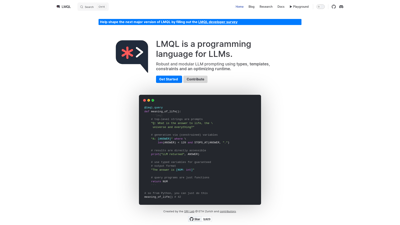LMQL is a powerful programming language designed for seamless interaction with large language models (LLMs). It offers robust features such as types, templates, and constraints, enabling users to create modular and efficient prompts. Whether you're a developer looking to enhance your AI applications or a researcher exploring the capabilities of LLMs, LMQL provides the tools you need to optimize your workflow and achieve precise results. With its user-friendly syntax and versatile functionality, LMQL is the go-to choice for anyone aiming to leverage the power of LLMs effectively.
LMQL
Features of LMQL
1. Modular Prompting
LMQL allows users to create modular prompts using nested queries. This feature enhances the reusability of prompt components, making it easier to manage complex interactions with LLMs.
2. Types and Constraints
With LMQL, you can define types and constraints for your variables, ensuring that the output adheres to specific formats. This is particularly useful for applications requiring structured data, such as numerical outputs or formatted strings.
3. Cross-Backend Compatibility
One of the standout features of LMQL is its ability to work seamlessly across different LLM backends. Users can switch between models like OpenAI and Hugging Face with a simple line of code, providing flexibility in model selection.
4. Python Integration
LMQL is designed to integrate smoothly with Python, allowing developers to leverage Python's control flow and string interpolation capabilities. This makes constructing prompts intuitive and straightforward.
5. Tool Augmentation
LMQL supports tool augmentation, enabling users to enhance their LLM interactions with additional functionalities. This feature is ideal for creating advanced chatbots or AI-driven applications that require dynamic responses.
6. Execution Trace
The execution trace feature provides a detailed overview of how prompts are processed, making it easier to debug and optimize your queries. This transparency is crucial for developers aiming to refine their interactions with LLMs.
7. Community and Support
Being an open-source project, LMQL benefits from a vibrant community of contributors and users. The documentation and community resources provide ample support for both new and experienced users, ensuring that help is always available when needed.
Frequently Asked Questions about LMQL
What is LMQL?
LMQL is a programming language specifically designed for interacting with large language models (LLMs). It provides a structured way to create prompts and manage outputs effectively.
How does LMQL handle different LLM backends?
LMQL is built to be compatible with multiple LLM backends. Users can easily switch between models like OpenAI and Hugging Face without changing their code significantly.
Can I use LMQL with Python?
Yes, LMQL integrates seamlessly with Python, allowing users to utilize Python's features for constructing prompts and managing outputs.
What are nested queries in LMQL?
Nested queries allow users to create modular and reusable prompt components. This feature simplifies the management of complex queries and enhances code organization.
Is there a community for LMQL users?
Absolutely! LMQL has an active community of users and contributors. You can find support and resources through the official documentation and community forums.
